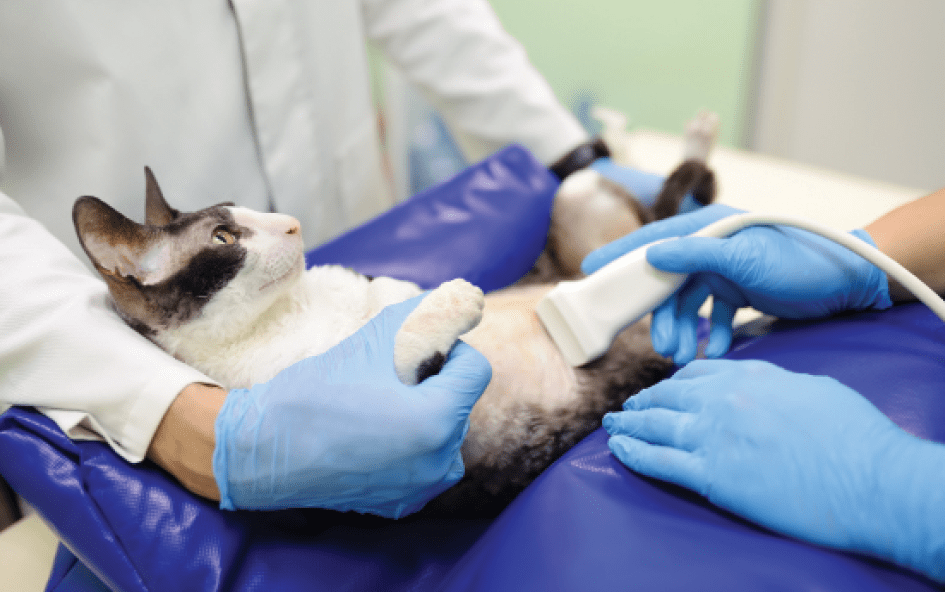A few years ago, I owned a wonderful and unique polydactyl cat named Mittens. She had many distinguishing personality traits and quirky characteristics in addition to her giant front feet. But Mittens was a vomiter.
If I came home and there was a puddle of cat vomit somewhere in the apartment, there was little doubt as to which of my cats was the culprit. Mittens was considerate enough to make a few bizarre vocalizations before she vomited, which was her way of saying to me, “You have 20 seconds to run and get some paper towels,” and most of the time I slid those towels in front of her just in the nick of time, sparing the couch or the rug.
Initially, the episodes were infrequent (maybe once a month), but as time went on, the frequency increased, and it became apparent that this wasn’t just a “sensitive stomach.” As a cat veterinarian, I had my suspicions, and after a variety of tests, they were confirmed. Mittens had inflammatory bowel disease.
What is IBD?
Inflammatory bowel disease (IBD) is a condition in which an excessive amount of inflammatory cells infiltrate the gastrointestinal (GI) tract, causing it to become chronically irritated and inflamed. All ages, genders and breeds can be affected, but it is most common in middle-aged and older cats.
The exuberant inflammatory response can affect different regions of the GI tract: stomach, small intestine or colon (large intestine).
- If the stomach is the primary site, we call the condition gastritis.
- If it’s the small intestine, it is termed enteritis.
- Inflammation of the large intestine is called colitis.
These all fall under the umbrella of inflammatory bowel disease.
Zeroing in on IBD
The clinical signs of IBD can mimic those of other disorders, making diagnosis challenging and necessitating a fairly extensive workup. For example, vomiting and weight loss are commonly seen in cats with kidney disease and/or hyperthyroidism, and these disorders need to be ruled out. Intestinal parasites, viral infections (like feline leukemia and feline immunodeficiency virus), food allergy and gastrointestinal cancer must also be considered when evaluating cats with the above clinical signs.
In cases of IBD, routine laboratory tests are often normal. On a biochemistry panel, an increase in the liver enzymes is sometimes seen, as some cats with IBD will have concurrent cholangiohepatitis — inflammation of the liver and bile ducts.
Abdominal X-rays might help rule out conditions such as a GI obstruction or an abdominal tumor, but they are ineffective for diagnosing IBD. Ultrasound provides more information, such as whether the intestinal walls are thicker than normal, if the pancreas is concurrently inflamed and if the lymph nodes associated with the GI tract are enlarged, findings that support (but still don’t confirm) a diagnosis of IBD.
To definitively diagnose feline IBD, biopsy specimens from the GI tract must be obtained in one of two ways:
1. Endoscopy is a procedure in which a long, flexible snake-like probe (the endoscope) enters the GI tract through the cat’s mouth (“upper GI endoscopy”) or anus (“lower GI endoscopy”), in order to visualize the internal lining of the GI tract and obtain biopsy specimens. Endoscopy offers advantages over surgery in that it is much less invasive; cats usually can go home the same day.
A significant limitation of endoscopy is that the endoscope can only reach the stomach and the first part of the small intestine (the duodenum). The sections further along the intestine (the jejunum and ileum) cannot be accessed with an endoscope. Another limitation of endoscopy is that the biopsy specimens obtained by this method consist only of the intestinal lining rather than a full-thickness biopsy of the intestinal tract. This can occasionally result in a misdiagnosis.
2. Exploratory surgery is more invasive, but allows better quality intestinal biopsy specimens to be taken. During surgery, the liver, pancreas and abdominal lymph nodes can also be inspected and biopsied if warranted. Your veterinarian will discuss with you, in detail, the pros and cons of each procedure and which would be most appropriate for your cat. Both procedures — endoscopy and abdominal exploratory surgery — require general anesthesia.
Treating IBD
Treatment involves suppression of the inflammatory response in the GI tract, usually through the use of prescription diets and immunosuppressive drugs.
Because dietary allergens have been implicated in some cases, a hypoallergenic diet may produce significant improvement. A hypoallergenic diet contains a protein source that the cat has never been exposed to before. There are numerous commercially manufactured hypoallergenic diets with novel protein sources, such as rabbit, venison and duck. There are also prescription diets in which the protein has been hydrolyzed into fragments that are too small to be detected by the immune system, preventing it from overreacting. These diets alone are inadequate at inducing long-lasting remission in cats with IBD.
Corticosteroids are the most commonly prescribed immunosuppressive drugs for IBD. Typically, oral prednisolone is given for at least two to four weeks. If clinical signs resolve, the dosage is slowly tapered until the lowest effective dose is reached. In cases of severe inflammation in which a dietary change and prednisolone are ineffective, other immunosuppressive drugs can be added to the protocol.
Although IBD isn’t curable, most cats respond well to treatment and live good quality, comfortable lives. After her diagnosis (at age 6), my Mittens responded well to treatment and lived relatively symptom-free for another eight years.

3 Comments